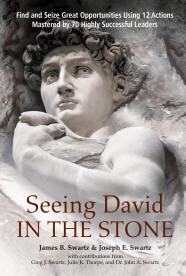I spent some time in Calgary and Pittsburgh this week, which afforded me some good plane time to chew through a new book I just received. Short review: Wow - you should check this one out!
 The book is "Seeing David In The Stone," by James B. Swartz and Joseph E. Swartz, and it is about how we can learn to be more effective at unlocking our opportunities and shaping our futures by studying the methods of some of the great geniuses of the past.
The book is "Seeing David In The Stone," by James B. Swartz and Joseph E. Swartz, and it is about how we can learn to be more effective at unlocking our opportunities and shaping our futures by studying the methods of some of the great geniuses of the past.
I think this is a great companion to Dick Richards' "Is Your Genius At Work?" which I reviewed about a year ago. Dick's book is about how to identify your personal, unique strengths, and this book provides some tremendous techniques to help you apply your genius in different ways to maximize the impact of that genius.
The book's an easy, enjoyable read and is presented as a sort of conversation between a learner and his mentor. It's a captivating story, laced with specific case studies of people like Einstein, Marie Curie, Michelangelo, Edison, Da Vinci, and a 65 other masters of their craft. A lot of the stories are from long-ago history, but you'll be pleased to find some spotlights of recent breakthrough successes, as well.
What's so special about this book?
I occasionally allude to some of the IT process consulting work I'm involved in as part of my 'day job,' but it's been more than just consulting. I've been privileged to be part of a groundbreaking research effort to observe and catalog the best known methods of high-performing IT organizations around the world. This research has led to some revolutionary, prescriptive guidance that enables any IT organization to benefit from the things the high performers have Darwinistically evolved on their own (shorten the learning curve, if you will).
"Seeing David In The Stone" has a similar feel to this IT research, since it catalogs and analyzes the practices of some of the most influential people in history. The book then provides a clear, ordered, 12-step process to help you tap into the best known methods of these highly successful leaders.
The practices are context- and industry-independent, and are well explained in the book. I read the book over the course of two flights this week, and found myself getting energized and excited about applying the principles in the book. Some of the concepts "clicked" so hard for me that I could literally feel the connection in my head.
I highly recommend this book for anyone who's involved in a creative pursuit, or who has the spirit of a learner, entrepreneur, or inventor.
Read More Josh Hinds has honored me by asking me to participate in an interview on his site, "Business Networking Advice". I'm the December 13th entry in a long series of 3-question interviews on the topic of business networking.
Josh Hinds has honored me by asking me to participate in an interview on his site, "Business Networking Advice". I'm the December 13th entry in a long series of 3-question interviews on the topic of business networking. 
 It's not all about you - find out more about the person you're negotiating with
It's not all about you - find out more about the person you're negotiating with

 My main symptoms, as you may recall, were:
My main symptoms, as you may recall, were: Whether you use Outlook or not; whether you use ClearContext or not; whether you use TWC or not, there are certain foundational principles I've learned that I think you can apply or develop from my experience. Here are some thoughts about what they are:
Whether you use Outlook or not; whether you use ClearContext or not; whether you use TWC or not, there are certain foundational principles I've learned that I think you can apply or develop from my experience. Here are some thoughts about what they are: